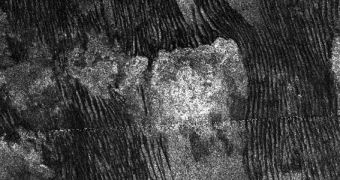Astronomers operating the NASA Cassini spacecraft were recently able to capture this beautiful radar image of dunes on the surface of Titan, the largest moon in orbit around Saturn. Though known for its similarities to our world, this celestial body usually does not feature identical landscapes. This photo, captured by astronomers with the European Space Agency (ESA), is definitely an exception.
Experts say that the dunes visible above are very similar to what we might find on a beach here on Earth or in a well-cared-for Japanese garden. However, the similarities stop here. While beaches here are made out of sand, or silicates, the ones on the Saturnine moon are composed almost exclusively of grains derived from organic materials, experts argue.
Both on Earth and Titan these particles are roughly the same size and feature comparable degrees of smoothness. This means that the lines carved into dunes appear equally dark to the human eye. Cassini was able to image these structures with its radar eyes, at wavelengths the human eye is not sensitive to. This was done in order to pierce the thick atmosphere surrounding the moon's surface.
The dune lines the spacecraft observed were most likely produced by prevailing winds on Titan, experts believe. These wind patterns most likely caused the dunes themselves to form at certain locations, and then carved them over prolonged periods of time. Cassini, a collaborative effort of NASA, ESA, and the Italian Space Agency, is perfectly suited for this type of studies.

 14 DAY TRIAL //
14 DAY TRIAL //